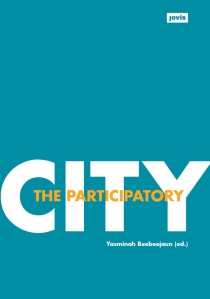The Participatory City & Participatory Sensing – new paper
The Participatory City is a new book, edited by Yasminah Beebeejaun  , which came out in March and will be launched on the 1st June. The book gather 19 chapters that explore the concept of participation in cities of all shapes and sizes. As Yasminah notes, concern about participation has started in the 1960s and never gone from urban studies – be it in anthropology, geography, urban planning, history or sociology.
, which came out in March and will be launched on the 1st June. The book gather 19 chapters that explore the concept of participation in cities of all shapes and sizes. As Yasminah notes, concern about participation has started in the 1960s and never gone from urban studies – be it in anthropology, geography, urban planning, history or sociology.
The book is structured around short chapters of about eight pages, with colour images that illustrate the topic of the chapter. This make the book very accessible – and suitable for reading while commuting in a city. The chapters take you for a tour around many places in the world: from London, Berlin, Bangalore, to Johannesburg, Mexico City and to small towns in Pennsylvania and Lancashire (and few other places). It also explores multiple scales – from participation in global negotiations about urban policy in the UN, to the way immigrants negotiate a small area in central Dublin, as well as discussion of master-planning in several places, including London and Mexico City.
The book demonstrate the multi-faceted aspects of participation: from political power, to gender, environmental justice, indigenous rights, skills, expertise and the use of scientific information for decision making. Each of the chapters provides a concrete example for the participatory issue that it covers, and by so doing, make the concept that is being addressed easy to understand.
Not surprisingly, many of the success stories in the book’s chapters are minor, temporary and contingent on a set of conditions that allow them to happen. Together, the chapters demonstrate that participation, and the demand for representation and rights to the city are not futile effort but that it is possible to change things.
With a price tag that is reasonable, though not cheap (€28, about £21), this is highly recommended book that charts the aspects of urban participation in the early part of the 21st century, and especially demonstrating the challenges for meaningful participation in the face of technological developments, social and economic inequalities, and governance approaches that emphasise markets over other values.
My contribution to the book is titled ‘Making Participatory Sensing Meaningful‘ and I’m examining how the concept of participatory sensing mutated over the years to mean any form of crowdsourced sensing. I then look at our experience in participatory sensing in Heathrow to suggest what are the conditions that enable participatory sensing that is matching the expectations from participatory processes, as well as the limitations and challenges. You can find the paper here and the proper citation for it is:
Haklay, M., 2016, Making Participatory Sensing Meaningful, in Beebeejaun, Y. (Ed.) The Participatory City, Jovis, pp. 154-161.
